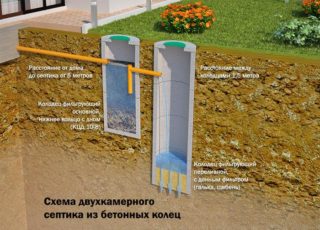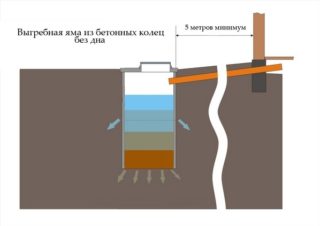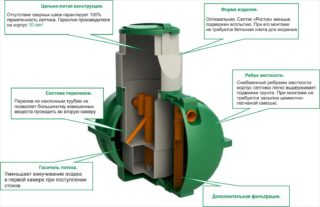If it is impossible to connect to a centralized sewage system, private houses are equipped with autonomous treatment facilities: a cesspool or septic tank. You can install a deep cleaning station, but it is expensive and requires electricity. The first two options are relatively inexpensive and non-volatile. If you understand the difference between a purchased or home-made septic tank and a cesspool, it’s easier to make a choice.
Advantages and disadvantages of the cesspool
This type of local sewage is a foundation pit with equipped walls. They are equipped with brickwork, poured with concrete or reinforced concrete rings are installed. Sometimes, cheaper materials use improvised materials, for example, old car tires. The bottom is covered with a mixture of sand and gravel for better filtering of sewage.
All wastewater is collected in the cesspool - it requires regular pumping with sewage equipment. It is necessary to equip the entrance to the structure so that the machine can easily get to the pit. This is difficult because the treatment plant needs to be installed away from residential buildings, wells and highways.
The rake is suitable only for summer cottages or small houses, where no more than two people live permanently.
The average daily amount of sewage cannot be more than a cubic meter. If it is exceeded, there is a risk of infection of the soil and subsoil waters, which leads to the penetration of infection into wells and other catchment points. You can not equip a cesspool in areas where subsoil sources are highly located. The distance between the bottom of the pit and groundwater is at least a meter.
The advantages of the treatment device are only its low cost and ease of installation. You can build a cesspool in the country yourself.
The design has many disadvantages:
- persistent "aroma" of the sewerage;
- the need for regular repairs;
- siltation of internal surfaces;
- systematic pumping of drains, which is not cheap;
- risk of contamination of soil and drinking water sources.
The decrease in sewer stench is facilitated by the addition of drugs with bioactive microorganisms to the cesspool. They help reduce the formation of methane and hydrogen sulfide. But this must be done regularly, which also requires financial costs and constant visits to the summer cottage.
The compromise between the cesspool and the septic device is to install a sealed container - a plastic or metal tank, where sewage will drain. This will reduce the risk of contamination of the soil and drinking water, save from miasma, but will not save from regular spending on pumping. But a sealed tank is well suited for areas with clay soil and with a high level of soil water.
Pros and cons of a septic tank
 The difference between a septic device is that such devices are equipped with biofilters. The cleaning microorganisms living in them quickly clarify sewage. The output is a sufficiently clean liquid that can be used for technical needs. For additional cleaning, septic tanks are equipped with filter fields, aerators and other devices that facilitate the clarification of effluents.
The difference between a septic device is that such devices are equipped with biofilters. The cleaning microorganisms living in them quickly clarify sewage. The output is a sufficiently clean liquid that can be used for technical needs. For additional cleaning, septic tanks are equipped with filter fields, aerators and other devices that facilitate the clarification of effluents.
Single chamber septic tanks are essentially similar to cesspools. They are also able to process per day to a cubic meter of sewage. If the house is large, it is reasonable to install a device with a large number of cameras.
The two-chamber overflow design is capable of absorbing 2 to 10 cubic meters of waste fluid. It consists of two wells and operates according to the following principle:
- In the first, sealed, solid waste settles to the bottom and is processed by microorganisms.
- The clarified liquid flows through a special pipe into the second well with a filtration bottom.
- There, it is clarified even more thanks to the filter and goes into the soil or is taken away for technical needs.
For a large cottage, where the volume of daily drains is more than 10 cubic meters, it is better to prefer a septic tank with three or more cameras. Create it yourself is impractical. It will be cheaper to buy a finished product with protection against cold and overloads, as well as ordering its installation. Modern designs are characterized by increased strength due to built-in stiffeners. They save from destruction and loss of tightness during soil vibrations.
The advantages of septic devices include:
- increased wastewater treatment;
- lack of sewer stink;
- strength and durability.
Remains of sewage must also be pumped out here, but this will have to be done every two to three years, and not monthly.
The disadvantages of septic tanks are the complexity of the construction and the high cost of finished structures, as well as regular spending on biological products. To install a dimensional device in several cameras, you need to find a place on the site.
The main differences between the septic tank and the cesspool
Village cesspools are a thing of the past. Septic tanks are a much more civilized way to handle domestic sewage. They are distinguished by:
- Bio-treatment and the possibility of sedimentation of waste liquids.
- Environmental safety and hygiene.
- Water clarification at the exit to 95 percent.
If the septic device is of high quality, the outlet liquid can be used not only for watering green spaces, but even for wet cleaning or a summer shower.
Another distinctive point is the price of arrangement of the treatment plant. In the case of a septic tank, it is much higher. But during maintenance, the additional costs will be repulsed: pumping of septic devices is much less common than cesspools.
Comparative analysis
Choosing which is better: septic tank or cesspool, first of all, evaluate your site. If it is tiny, there is simply no room for multi-chamber designs. There is also no sense in a functional cleaning device in the country, where the family comes for weekends and holidays. But with permanent residence and a large number of guests, septic tanks are preferred.
In the presence of a garden and a kitchen garden, the advantages of a septic tank over a cesspool are obvious. Do not have to spend money on water for irrigation. A high-quality septic device at the outlet produces a sufficiently clean liquid to nourish the plants with it.
In terms of labor costs for independent installation, both structures are approximately the same: you have to dig a pit, equip the walls or immerse a plastic container. But building materials to create a cesspool are usually cheaper.
If the owner of a house, where his family lives permanently, values the environment and the health of loved ones, he will opt for a septic tank. Spent funds will not go into the void. The design will save on regular pumping. The sewer system will operate without interruption for at least 20 years. In the case of a cesspool, it will have to be reanimated in ten years and measures will be taken to bio-clean the soil and water sources. Given this, the cost of installing a septic tank is quite justified.




